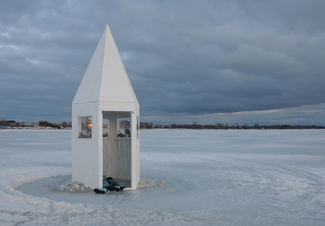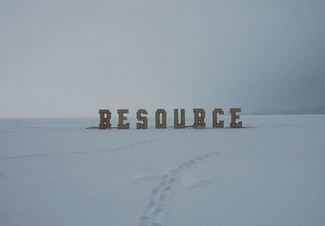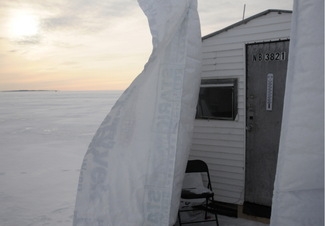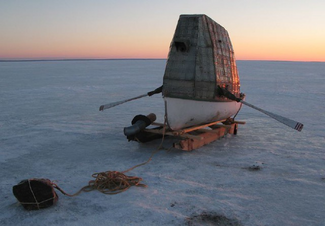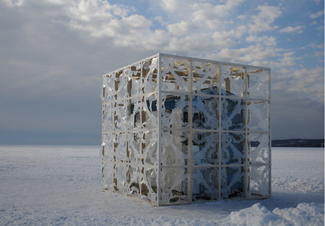Ice Follies 2008
February 23rd - March 17th, 2008Presented Artists
Out There on Thin Ice
Essay by Ernest Daetwyler Taken from 2008 Program
Listening to a frozen lake, a fortune-telling fish, a “Great Lakes Institute”, and experiencing a cube of floral patterns, a “dead body” and large letters in ice through one eye aperture.
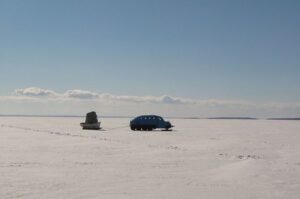 Approaching the vast frozen lake environment after a long drive north, one notices the intensely bright light, the cold wind, and the warm, pleasant sensation of the sun on your face’s skin. Looking out from the harbor into the blinding white desert, the six hundred square kilometer frozen plateau of Lake Nipissing, one identifies a series of intriguing structures, and groups of moving dark dots soon can be identified as human beings.
Approaching the vast frozen lake environment after a long drive north, one notices the intensely bright light, the cold wind, and the warm, pleasant sensation of the sun on your face’s skin. Looking out from the harbor into the blinding white desert, the six hundred square kilometer frozen plateau of Lake Nipissing, one identifies a series of intriguing structures, and groups of moving dark dots soon can be identified as human beings.
Ice Follies, a site-specific biennial of contemporary art interventions on a frozen lake in Canada’s North is a curatorial project presented by Dermot Wilson, Director of the W.K.P Kennedy Public Art Gallery and a very innovative curator with a strong background in artist-run culture. For the 2008 Ice Follies, the third incarnation of the biennial, he selected a group of contemporary visual artists across the country to relate to the cultural tradition of “Ice Huts” and “Ice fishing”, a popular tradition and social winter sport. During the ice fishing season, little villages and temporal communities form out on the ice, social gatherings in a bizarre space. What is most relevant to Wilson is how the visit in contemporary artists responded to this concept and engaged with the local community.
The frozen lake environment, a seemingly most unusual place for a public art project provided a striking natural context and background for the seven art installations.
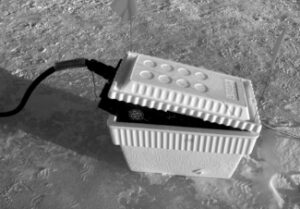 Peter Nickle listens to the lake, the lake where we live. For Ice Follies, he installed the audio installation Ice Cracks consisting of several small condenser microphones and various arrangements of custom-made and commercially available audio equipment embedded and cast in the ice. Stationed in a recreational trailer/media production space, the “Near North Media Lab”, he received, recorded, and replayed the multi-channel recordings of sound bites from the ice. Nickle describes the project as both a real-time representation of what is happening on the ice and the documentation of the soundscape created by the freezing of the water from the top of the lake down. To his surprise, the most prominent sound fields consist of roars and groans in the low hertz region, cracks, and surprisingly little man-made noise as steps on the snow or scratches by equipment used can be heard. With recording and amplifying these audio signals of the frozen shield, Peter Nickle opened a new dimension in the experience on the ice and gave the lake a live voice as a moving natural organism – a brilliant concept communicating urgency in a new way.
Peter Nickle listens to the lake, the lake where we live. For Ice Follies, he installed the audio installation Ice Cracks consisting of several small condenser microphones and various arrangements of custom-made and commercially available audio equipment embedded and cast in the ice. Stationed in a recreational trailer/media production space, the “Near North Media Lab”, he received, recorded, and replayed the multi-channel recordings of sound bites from the ice. Nickle describes the project as both a real-time representation of what is happening on the ice and the documentation of the soundscape created by the freezing of the water from the top of the lake down. To his surprise, the most prominent sound fields consist of roars and groans in the low hertz region, cracks, and surprisingly little man-made noise as steps on the snow or scratches by equipment used can be heard. With recording and amplifying these audio signals of the frozen shield, Peter Nickle opened a new dimension in the experience on the ice and gave the lake a live voice as a moving natural organism – a brilliant concept communicating urgency in a new way.
 This surreal nature of the frozen lake environment seemed to inspire humor and Kevin Yates (Toronto), Marcy Adzich (Oregon), and Donavan Barrow (New York) employed this medium in their project To Catch A Fish Takes Luck, an installation of an ice hut shrine built around and especially for a fortune-telling fish.
This surreal nature of the frozen lake environment seemed to inspire humor and Kevin Yates (Toronto), Marcy Adzich (Oregon), and Donavan Barrow (New York) employed this medium in their project To Catch A Fish Takes Luck, an installation of an ice hut shrine built around and especially for a fortune-telling fish.
The project explored stories and tales of ice fishing, good luck, bad luck, drunkenness, etc. and the hut itself looked a lot like the place where many freak accidents had occurred. A tree, felled by a beaver, penetrated the ice hut only to be integrated into the structure and a wooden furnace seemed to have been catapulted into an upper window, definitely not indications of luck….. Coming closer, the hut featured prominently a fortune-telling rubber fish on the ground moving lips and upper body and offering advice such as: “everything will now fall into place…. You should be proud of your achievements…. Touching is not always the best way to feel…. You will win a major award (sound of trumpets)…. This is the final countdown….. The final countdown.” The artists, who met at the University of Victoria, created in collaboration a humorous, complex, and fun installation with materials and objects found in North Bay. The project addressed issues of belief, storytelling, superstition and offered advice as to what the future might hold for each visitor, sure to leave a smile.
 The surreal experience of the ice environment further inspired humor in H.O.M.E.S: Expedition Model, a white inflatable camouflage structure, containing an existing ice hut. “it is really all about nothingness….’ deadpanned Derek Knight. Together with team members Melissa Smith and Duncan McDonald, the collective from St. Catherine’s became a fictional socio-scientific research expedition and explore the question: should Lake Nipissing become an official “Great Lake” or not? The title H.O.M.E.S referred to the actual great lakes Huron, Ontario, Michigan, Erie, in Superior. The public was invited to fill out forms and contribute “data and information” to this “controversial subject” and other questions as well. In the office, the visitors were invited to file info in a large interactive cabinet with numerous drawers labeled as “Boredom Drawer, Deadlines, Humour in Nature, Love letters, Natural artifacts Lake Nipissing, etc.” The multi-disciplinary politico-scientific and dataesque approach engaged visitors to respond to the tongue-in-cheek experiment with forms, votes, drawings, and personal items thoughts contributing “data” and voicing their opinion if Lake Nipissing should be designated to achieve official “Great Lake” status or not.
The surreal experience of the ice environment further inspired humor in H.O.M.E.S: Expedition Model, a white inflatable camouflage structure, containing an existing ice hut. “it is really all about nothingness….’ deadpanned Derek Knight. Together with team members Melissa Smith and Duncan McDonald, the collective from St. Catherine’s became a fictional socio-scientific research expedition and explore the question: should Lake Nipissing become an official “Great Lake” or not? The title H.O.M.E.S referred to the actual great lakes Huron, Ontario, Michigan, Erie, in Superior. The public was invited to fill out forms and contribute “data and information” to this “controversial subject” and other questions as well. In the office, the visitors were invited to file info in a large interactive cabinet with numerous drawers labeled as “Boredom Drawer, Deadlines, Humour in Nature, Love letters, Natural artifacts Lake Nipissing, etc.” The multi-disciplinary politico-scientific and dataesque approach engaged visitors to respond to the tongue-in-cheek experiment with forms, votes, drawings, and personal items thoughts contributing “data” and voicing their opinion if Lake Nipissing should be designated to achieve official “Great Lake” status or not.
 Furthest out on the lake was the One Eye Folly, a camera obscura/pinhole project in the form of a sled/boat/shack/shelter hybrid meticulously crafted by Kamloops artist, Donald Lawrence. This cultural work, complete with the runners, was clad in tin tiles inside and out. An aperture, protected by a tin hood at the front of the structure turned the sculptural work into a ‘camera obscura’, projecting an image of Lake Nipissing’s environment into its interior and onto the back door. The title “One Eye Folly” may refer to the “camera obscura” technique but it also seems to suggest the image of a “one-eyed pirate” as featured in many children’s stories. Lauren says complexion, with the red, well-grown be and rugged clothing sleeping in his invention out on the frozen lake certainly communicates an image of the artist as an explorer of unknown lands. In his case Lawrence is exploring, it seems, for unknown visual and sensual territory. With all light sources entering the warm cocoon-like space eliminated, the One Eye Folly allows visitors to go on a journey strictly based on the projected (and inverted) image on the back door; an interesting thought as one now perceives the reality of the outside world indirectly through a visual medium. We are, in a sense, navigating by the projected image. The pinhole projection introduced an upside-down world to the interior of the piece. In the surreal frozen lake environment where are vast white desert meets the blue sky, this image became a surprisingly plausible visual statement.
Furthest out on the lake was the One Eye Folly, a camera obscura/pinhole project in the form of a sled/boat/shack/shelter hybrid meticulously crafted by Kamloops artist, Donald Lawrence. This cultural work, complete with the runners, was clad in tin tiles inside and out. An aperture, protected by a tin hood at the front of the structure turned the sculptural work into a ‘camera obscura’, projecting an image of Lake Nipissing’s environment into its interior and onto the back door. The title “One Eye Folly” may refer to the “camera obscura” technique but it also seems to suggest the image of a “one-eyed pirate” as featured in many children’s stories. Lauren says complexion, with the red, well-grown be and rugged clothing sleeping in his invention out on the frozen lake certainly communicates an image of the artist as an explorer of unknown lands. In his case Lawrence is exploring, it seems, for unknown visual and sensual territory. With all light sources entering the warm cocoon-like space eliminated, the One Eye Folly allows visitors to go on a journey strictly based on the projected (and inverted) image on the back door; an interesting thought as one now perceives the reality of the outside world indirectly through a visual medium. We are, in a sense, navigating by the projected image. The pinhole projection introduced an upside-down world to the interior of the piece. In the surreal frozen lake environment where are vast white desert meets the blue sky, this image became a surprisingly plausible visual statement.
 The installation Cache was created by Jeannie Thib, a Toronto-based visual artist originally from North Bay, consisted of an elegant, nine feet cube of elaborate, white fabric patterns built around an existing ice hut. Using a “Faience tile” pattern from the 19th Century that she discovered in a tile museum in Toulouse, France, Thib multiplied the floral motive and cut it in “fabrene”, a white plastic tarp produced in North Bay.
The installation Cache was created by Jeannie Thib, a Toronto-based visual artist originally from North Bay, consisted of an elegant, nine feet cube of elaborate, white fabric patterns built around an existing ice hut. Using a “Faience tile” pattern from the 19th Century that she discovered in a tile museum in Toulouse, France, Thib multiplied the floral motive and cut it in “fabrene”, a white plastic tarp produced in North Bay.
These deconstructed and rearranged intricate floral patterns intended for domestic environments seemed exotic in this harsh outdoor environment but enlarged, multiplied, and stretched on a large, minimal frame, the repeating semi-transparent, translucent ornaments became form and, through the changed perspective of the viewer viewing the patterns the perception of the landscape was altered. This semi-transparent, translucent grids of the baroque fabric ornaments and the purity of the cube appeared to wrap around the worn ice hut as a beautiful, imaginative, even sacred place, or an elaborate artificial dream around a harsher reality.
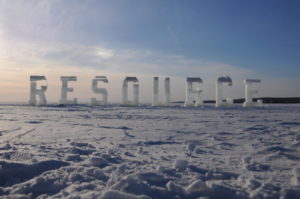 Resource, a structural work by environmental artist Nicole Dextras from Vancouver, featured the titles eight large literally spelled out and cast in ice. The lake and the water labeled as a singular business term did raise valid and present questions regarding our environment, the most pressing concern of Canadians before the economic bubble burst, and our society’s history of exploiting all natural resources available. In our communication, Dextras further pointed out issues of ownership of water from a political perspective in local, national, and international terms, particularly with the polar ice melting and our environment drastically changing.
Resource, a structural work by environmental artist Nicole Dextras from Vancouver, featured the titles eight large literally spelled out and cast in ice. The lake and the water labeled as a singular business term did raise valid and present questions regarding our environment, the most pressing concern of Canadians before the economic bubble burst, and our society’s history of exploiting all natural resources available. In our communication, Dextras further pointed out issues of ownership of water from a political perspective in local, national, and international terms, particularly with the polar ice melting and our environment drastically changing.
The letters are large, seven-foot-tall, produced in plywood, and filled with water on-site (crews pumped lake water into the “letters”). Once the water was solidly frozen the plywood was removed. A transparent lucid quality of the sculpture seemed to visually connect the ice plateau with the sky. The sun, light, and darkness changed the visual appearance of this project in the most beautiful ways throughout each day. An ephemeral work, the water from the lake used in the letters eventually returned to join the elements natural cycle.
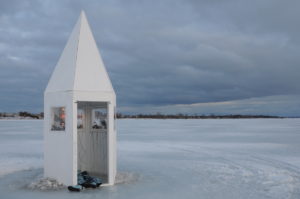 Approaching Christine Charette and Jeremy Bean’s crystal-like hut Rewind In Fast Forward, I heard a voice behind me: “Oh there is a dead man, that’s good…” and indeed, moving closer one noticed a blue body in paint-splattered work overalls lying headfirst in the hut, which looked like the crystal, or an ice pond. The body turned out to be a puppet with strings connected to a bicycle wheel at the ceiling. The windows of the hut consisted of frozen ice panels with the beautifully arranged compositions of wheels, gears, toy cars and airplanes, and other historical pop-culture artifacts from the past century as well as text. The artist used wheels, gears, and circular objects as symbols for our society’s past, industrial and human progress, and possible indications for the future.
Approaching Christine Charette and Jeremy Bean’s crystal-like hut Rewind In Fast Forward, I heard a voice behind me: “Oh there is a dead man, that’s good…” and indeed, moving closer one noticed a blue body in paint-splattered work overalls lying headfirst in the hut, which looked like the crystal, or an ice pond. The body turned out to be a puppet with strings connected to a bicycle wheel at the ceiling. The windows of the hut consisted of frozen ice panels with the beautifully arranged compositions of wheels, gears, toy cars and airplanes, and other historical pop-culture artifacts from the past century as well as text. The artist used wheels, gears, and circular objects as symbols for our society’s past, industrial and human progress, and possible indications for the future.
Rewind In Fast Forward inspired wonder and curiosity and left a lot of room for the viewer’s interpretation. The question remained if the puppet drives the wheel, or the wheel drives the puppet.
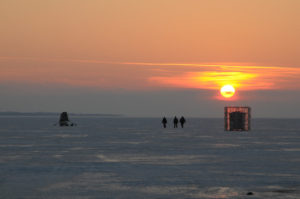 The approaches and the variety of artistic disciplines employed by the artists ranged from new media, ephemeral work, multimedia installations with found objects to interactive projects and engaging the public. A common thread seemed to be the idea of documenting and recording. This was evident in Peter Nickles audio installation listening in on the lake with Ice Cracks, Donald Lawrence One Eye Folly camera obscura/ pinhole project observing the environment, Jeannie Thib’s Cache, and the use of antique French tile patterns in her fabric installation, H.O.M.E.S: Expedition Model and their altered file drawer/office/research space to record data, statements, and votes of visitors, as well as the “invented accidents” of To Catch A Fish Takes Luck where an installation of found materials and objects ironically documents how bad luck can potentially manifest…art. Further, the intention to document became clear in the ice preserved artifacts from Christine Charette’s Rewind In Fast Forward and again in Resource, documenting and transforming a most important concern of our society into an ephemeral sculpture of light and ice.
The approaches and the variety of artistic disciplines employed by the artists ranged from new media, ephemeral work, multimedia installations with found objects to interactive projects and engaging the public. A common thread seemed to be the idea of documenting and recording. This was evident in Peter Nickles audio installation listening in on the lake with Ice Cracks, Donald Lawrence One Eye Folly camera obscura/ pinhole project observing the environment, Jeannie Thib’s Cache, and the use of antique French tile patterns in her fabric installation, H.O.M.E.S: Expedition Model and their altered file drawer/office/research space to record data, statements, and votes of visitors, as well as the “invented accidents” of To Catch A Fish Takes Luck where an installation of found materials and objects ironically documents how bad luck can potentially manifest…art. Further, the intention to document became clear in the ice preserved artifacts from Christine Charette’s Rewind In Fast Forward and again in Resource, documenting and transforming a most important concern of our society into an ephemeral sculpture of light and ice.
Presenting a cohesive exhibition in the public realm, particularly in the most unforgiving environment of a frozen lake in the Canadian North, a white canvas with frostbite temperatures and potentially raging elements is a formidable task. The participating visual and media artists answered these challenges with camaraderie and humor, intelligent and inspired concepts, healthy survival instincts, the innovative use of a variety of media to see and to hear, new ways to engage the community, and large, ephemeral work which made the 2008 biennial a relevant and exciting experience way out there on the ice.
Official 2008 Program
Acknowledgments
Taken from 2008 Catalogue
For this third incarnation of ice follies, WKP Kennedy Gallery staff and curators were ably assisted by a small army of volunteers. We all met early in February to divide up into committees and artist teams and to just start the word-of-mouth going around in the community. In 2008, Jean-Marc Raymond, curatorial assistant, was focused on the Ice follies pre-production project. He assisted with the media contacts, committee organization, and volunteer placement. Jean-Marc also worked with Near North Mobile Media Lab and membership to prepare for the video documentation. Liz Lott was, again and just as she was for Ice Follies 2006, dedicated to the show and to documenting every moment of its life upon the lake. Her green snowsuit and a little sled full of photo gear were a constant presence throughout February and March. As in 2006, the WKP Kennedy Gallery was assisted in 2008 by many individuals and businesses in North Bay and the area. Without this dedication and open-hearted generosity of spirit, effort, and time, this event could not have succeeded.
In these acknowledgments, I want to first thank the people that made this show happen. They are Bayden Brownlee and his wife Beth ( who once again drove us, hauled us, made light of the heaviest situations, and guided us out onto the ice), Dee Adrian (who always opens the doors of her art centre to all true artists), Perry Trinier ( who created our website and assisted everyone with everything), Andrew Van Schie (installation wizard who truly DID make this show happen!!!) and all the students, Gallery members, community volunteers, and friends who made this event the wonder it was. This year we also had a great deal of help from a small business near Deep Water Bay on the south shore, J. Andrew & Daughter. This family-run business donated three fish huts to the cause and we thank them for their support and involvement in the Ice Follies phenomenon!
North Bay is a community of small businesses. The ice Follies project could not have succeeded without the help of many generous, Community-spirited companies.
These include Dolphin Motel & Cottages, Snapdragon Photography, Dent’s Camera Centre, Donald M. Seguin Ltd. Commercial Contracting, United Rentals, Solvent Magazine, National Car and Truck Rental, Michelle’s Frame Maker & Gallery, Sparrow-Brown Ltd., See More Graphics, The Murdoch Group, Moyer Printing Ltd., The City of North Bay Department of Parks and Recreation, and The Mayor’s Office, The Lake Nipissing Stewardship Council, the staff and volunteers of the Capitol Centre, and all the downtown businesses that truly got into the spirit of the show.
We are also indebted to provincial and federal arts and cultural funding bodies and to the City of North Bay for annual operating funding. In particular, The Canada Council for the Arts has been the major cultural sponsor for Ice Follies since its inception. Both the events themselves and the 2008 catalogue were made possible through grants from the Department of Visual Arts at the Canada Council. Please support the Canada Council for the arts by telling your MP about this important art event. The Ontario Arts Council is the main funding body for the W.K.P Kennedy Gallery and, as such, was also an important source of support for this site-specific project.
In closing, I would like to thank the permanent staff of the Kennedy Gallery, Perry Trinier, Sheila Lavack, and Michelle Trinier, and our Board of Directors. Chairperson, Jane Limina was a constant source of support, always a true friend to the arts in her city. Board members, Keith Campbell, Peter Magill, Nepher Lewis, Steven Sopinka, Arlie Hoffman, Eileen McGowan, Michelle Courville, and Hilary Earl worked on many different fronts to make this project a success.

